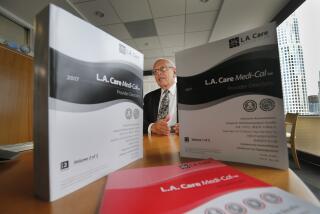Health benefits are a promise school districts find hard to keep

California school districts once viewed lifetime healthcare coverage for employees as a cheap alternative to pay raises. That decision is coming back to haunt school leaders, and districts are scrambling to limit the lucrative benefit promised decades ago.
The price tag for retiree healthcare obligations has reached about $20 billion statewide — an amount systems are not prepared to absorb.
Many districts failed to set aside money to pay for those increasingly expensive benefits for thousands of employees. Now, the financial burden threatens to drag down credit ratings and crowd out other budget priorities.
Largest among those districts is Los Angeles Unified. The unfunded debt for providing lifetime health insurance to retirees and their dependents has more than doubled since 2005, leaving the nation’s second-largest school district on the hook for nearly $11 billion in future costs. The district would have to pay $868 million annually for 30 years to fully fund retiree healthcare obligations.
“It’s scary,” said Megan Reilly, chief financial officer for the Los Angeles Unified School District. “It has been a growing concern that our liabilities have been increasing year after year and slowly becoming larger than our assets. We’re not there yet, but we probably have a couple of years to go.”
Reilly said a decrease in state funding, stemming from a decade loss of more than 150,000 students and increases in costs tied to a growing retiree population, demand that the school district reevaluate employee and retiree healthcare coverage.
United Teachers Los Angeles officials say that attempts to eliminate or reduce retirees’ healthcare aren’t new but that the union will continue to fight for those benefits.
About 70 of California’s 1,000-plus school districts provide some type of lifetime health benefits to retired employees. Hundreds of those offer limited retiree benefits up to age 65, transferring health costs to the federal government once the former employees qualify for Medicare.
Financial analysts and district officials say shouldering the costs of promises made decades ago has grown increasingly difficult. Instead of building up savings by pre-funding retiree health coverage during an employee’s tenure, districts tap annual budgets to pay the benefits as they are claimed.
The practice is not unique to school districts.
California Common Sense, a nonpartisan research group founded at Stanford University, estimates that state government, cities including San Francisco and Los Angeles and the University of California system contribute to $157 billion in statewide retiree healthcare obligations. Only about $7 billion has been set aside by those surveyed by the group, leaving $150 billion in debt.
Nationally, the unfunded cost of providing non-pension retirement benefits, primarily healthcare coverage, is nearly $530 billion, according to a November report from Standard & Poor’s, the credit rating agency.
“It’s a train wreck that is going to have to be dealt with in the future,” said Martin Tokunaga, a financial consultant who works with the California School Boards Assn. “It’s going to cause so much financial distress to public agencies that, in my mind, I can’t see how any agency will be able to keep its promises.”
Setting aside money to pay healthcare obligations was not a priority for districts across the state that have struggled to fund critical educational programs. The recession forced school systems to lay off or furlough teachers, increase class size and cut other programs and services.
Aside from healthcare costs, school districts must pay into the state teacher pension fund. The state last year approved a plan to close a $74-billion shortfall in that fund, which requires districts and employees to absorb a greater percentage of contributions.
As school districts search for ways to rein in costs, officials will look at retiree health benefits, which enjoy fewer legal protections than pensions, said Adam Tatum, research director for California Common Sense.
“You’re going to see more attempts to reduce benefits, maybe not for current employees but for new employees,” Tatum said. “Retiree health benefits may be the low-hanging fruit.”
The Fresno Unified School District was on the brink of bankruptcy a decade ago when it scaled back healthcare promises made to employees, retirees and their dependents.
The 73,000-student district had a budget deficit and was facing the threat of a state takeover. One of the key culprits cited was the skyrocketing cost of a fully paid health benefits package without deductibles or co-payments. The cost of providing the lifetime benefit to retirees and their dependents reached $24 million in 2005 and was projected to grow to $80 million annually, not counting any new retirees.
District officials negotiated with the teachers union to add a $250 deductible, co-pays for doctor visits and to cap the amount spent on healthcare. The district also ended lifetime healthcare benefits for all employees hired after July 2005. And unions were given more of a say in the management of healthcare benefits.
“There has to be an appropriate sense of urgency to motivate both sides to make significant change,” said Ruth Quinto, Fresno’s deputy superintendent and chief financial officer. “The unions agreed. They understood that this era of having basically free was no longer feasible.”
Fresno Unified has $820 million in retiree healthcare obligations, which is lower than the $1.1 billion it owed a decade ago.
The district is one of many that have renegotiated long-standing healthcare coverage agreements in an attempt to lower costs.
The Los Angeles and Sacramento unified school districts maintain some of the most lucrative healthcare benefits across the state. The districts provide lifetime health coverage to retirees and their dependents without requiring them to pay premiums.
Continuing the plans with no changes is unsustainable, according to officials for both districts.
“When you look back at when these commitments were made, health insurance was not as expensive. It was not the commitment it is today,” said Gerardo Castillo, Sacramento Unified’s chief business officer. “Employees took lower salaries in order to get that benefit, but that was a long time ago. Since then, health insurance has increased year after year. We believe it is something they’ve earned. We just have to figure out how to fund it.”
Sacramento Unified’s retiree healthcare obligations are estimated at $633 million.
L.A. Unified will spend up to $290 million this year on healthcare coverage for 37,517 retirees and their families. The benefits and an additional $78 million that the district will set aside for future costs make up nearly 6% of the district’s $6.4 billion budget.
District officials are planning to bring lifetime benefits to the negotiating table — a move that could set the stage for another heated battle with teachers unions. The district and the teachers union in February declared an impasse in negotiations over salary increases and class sizes.
John Perez, president of retired teachers for UTLA, said L.A. Unified already has made it more difficult for employees to qualify, requiring a combined age and length of service of 85 years.
“They’ve always wanted to get rid of lifetime health benefits for employees, but none of the unions are willing to give that up,” Perez said. “It’s one of the few benefits we have left.”
The warning call came a decade ago for L.A. Unified, which has been offering lifetime benefits since the 1960s.
The district needed to set aside $500 million annually for 30 years to cover the $5-billion unfunded debt from retiree benefits and to meet future obligations, according to a 2005 state budget analysis by the nonpartisan Legislative Analyst’s Office.
Still, L.A. Unified didn’t start placing money in an irrevocable trust until last year, when it set aside $90 million. The district saved $81 million in previous years intended for retiree benefits, but the school board has not approved placing the money in the trust.
Since 2005, the district’s unfunded debt has doubled, and credit rating agencies have asked what steps are being taken to address the liability.
Reilly said that the district typically is looked upon favorably but that those agencies are concerned about the debt.
“We always get ‘wow, that’s a really big number; what are you going to do about it?’ ” she said.
Twitter: @zahiratorres
More to Read
Sign up for Essential California
The most important California stories and recommendations in your inbox every morning.
You may occasionally receive promotional content from the Los Angeles Times.











